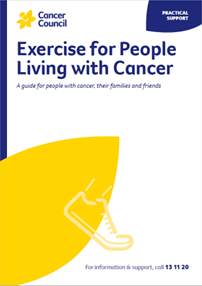Getting started
Discover how to get started with exercise during cancer treatment. Talk to your doctor, start slow, and find what works best for you.
Learn more about:
- Overview
- Exercise equipment
- Seeing an exercise professional
- Making an exercise program
- How to find an exercise professional
- Tips for starting an exercise program
- Planning an exercise session
- The different muscle groups
Overview
Before you start exercise, it’s important to talk to your doctor or oncologist about the exercise that’s best for you, how much to do and any precautions you should take. Ideally, your doctor can refer you to an exercise physiologist or physiotherapist for a health and fitness assessment and exercise plan designed for you.
The amount of exercise outlined here can feel overwhelming. Aim to be as physically active as your abilities allow and adapt your exercise program to suit the type and stage of cancer. Some days may be harder than others, but even a few minutes of light exercise is better than none. It’s usually best to start physical activity slowly and build up gradually, instead of doing too much and exhausting yourself.
Exercise equipment
You don’t need expensive equipment or special clothing to exercise, but suitable shoes are essential. Visit a reputable shoe shop for suggestions. Wear loose, comfortable clothes, such as shorts and a T-shirt, when exercising. Other equipment, such as activity monitors, weights, heart rate monitors and home-gym systems, can be useful but are not necessary.
Seeing an exercise professional
Personal trainers, fitness instructors and exercise scientists aren’t trained to work with people affected by cancer.
The appropriate allied health professionals to design an exercise program for people with cancer are:
| Exercise physiologists | Also called accredited exercise physiologists (AEPs), these allied health professionals have completed at least a 4-year university degree. They use exercise as medicine to help with chronic disease management and overall wellbeing. |
| Physiotherapists | These allied health professionals have completed at least a 4-year university degree. They focus on physical rehabilitation, and prevention and treatment of injuries using a variety of techniques, including exercise, massage and joint manipulation. |
Making an exercise program
An exercise professional can help develop a program based on what you can do, and any health issues, physical problems, disease impacts or treatment side effects related to the type and stage of cancer you have. You may go to one-on-one or group sessions, or your exercise professional may develop a program for you to follow at home.
They will show you how to exercise safely and monitor the intensity of your exercise (e.g. by measuring your heart rate or how difficult it feels to do). If you can’t see an exercise professional, guides in this section may help.
How to find an exercise professional
There may be an exercise physiologist or a physiotherapist at your cancer treatment centre who you can see. If not, your general practitioner (GP) can refer you to an exercise physiologist or a physiotherapist as part of a chronic disease management plan (which means you may be eligible for a Medicare rebate for up to 5 visits per calendar year).
In most cases, you will still have to pay to see an exercise professional. Check with your health insurer if they cover seeing an exercise physiologist or a physiotherapist. The Department of Veterans’ Affairs may also be able to financially assist some people.
When you look for an exercise professional, ask to see someone with experience working with people who have cancer.
Search for an accredited exercise physiologist (AEP) by name, location or specialty (i.e. cancer) at Exercise & Sports Science Australia. Search for a physiotherapist at Australian Physiotherapy Association.
To find a group exercise program, ask at your cancer centre, ask your GP for a referral or call Cancer Council 13 11 20.
→ READ MORE: Tips for starting an exercise program
Podcast: Meditation and Relaxation
Listen to more of our meditation and relaxation podcast for people affected by cancer
More resources
Kirsten Adlard, Accredited Exercise Physiologist, The University of Queensland, QLD; Dr Diana Adams, Medical Oncologist, Macarthur Cancer Therapy Centre, NSW; Grace Butson, Senior Physiotherapist, Peter MacCallum Cancer Centre, VIC; Kate Cox, 13 11 20 Consultant, Cancer Council SA; Wai Yin Chung, Consumer; Thomas Harris, Men’s Health Physiotherapist, QLD; Clare Hughes, Chair of Cancer Council’s Nutrition, Alcohol and Physical Activity Committee; Jen McKenzie, Level 1 Lymphoedema Physiotherapist, ESSA Accredited Exercise Physiologist, The McKenzie Clinic, QLD; Claudia Marck, Consumer; Dr David Mizrahi, Accredited Exercise Physiologist and Research Fellow, The Daffodil Centre at Cancer Council NSW and The University of Sydney, NSW; Prof Rob Newton, Professor of Exercise Medicine, Exercise Medicine Research Institute, Edith Cowan University, WA; Jason Sonneman, Consumer.
View the Cancer Council NSW editorial policy.
View all publications or call 13 11 20 for free printed copies.

